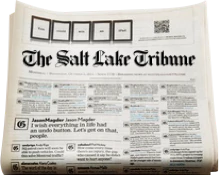This is an archived article that was published on sltrib.com in 2007, and information in the article may be outdated. It is provided only for personal research purposes and may not be reprinted.
A classic 1940s diner from Rhode Island began a cross-country road trip Tuesday, headed for the northern Utah town of Oakley, where it ultimately will serve up comfort food and a slice of Americana.
"It's unique. There's nothing in the state like it," said Keith Walker, the Oakley business owner who bought the futurist green and yellow diner for $27,000 from the American Diner Museum. His offer was accepted over those from four other U.S. cities.
The diner, which is 60 feet long and 16 feet wide and seats 60 people, is expected to arrive in Utah Saturday or Sunday. Walker plans to call it "The Rhode Island Diner."
"One of the things that helped us get it was that there isn't anything like this out West," Walker said.
Many restaurants carry the "diner" name, but, according to the experts, a true diner is a prefabricated structure built and assembled at a plant and moved to its permanent location. Usually built in the shape of a railroad car, they are sleek, metallic and futuristic looking.
But they are a dying breed. Once there were about 6,000 of these free-standing buildings serving hamburgers, fried chicken and apple pie. Today, only about 1,200 remain.
Once the diner is situated on the corner of State Road 32 and Weber Canyon Road, Walker will spend the next eight to 10 months remodeling it to its original form. He hopes to be serving "classic comfort food" by July 4, 2008, the weekend of the famed Oakley rodeo.
"We're famous for our rodeo, but we wanted something else to draw people to our town. Something unique," Walker said.
By the time he pays moving costs, restores the inside of the diner and constructs an outbuilding at the rear of the diner for restrooms and storage, Walker estimates the diner will be a $600,000 to $700,000 investment.
Fortunately, the streamline-style diner is mostly intact. The exterior is wrapped in stainless steel and porcelain enamel panels. It contains its original terrazzo tile floors and mahogany woodwork trim. All 20 of the original stools remain as does the back bar, fancy grill hood and stainless steel-clad refrigerator.
Walker, who has pictures of the original interior, plans to have the 36 booths remanufactured to be authentic.
Once completed, Walker and Oakley leaders believe the diner will serve as a cornerstone for the city's downtown redevelopment.
About four years ago, Oakley moved its old rodeo grounds to the outskirts of the city, with the idea of creating a tourist destination in the center of town, something similar to Jackson Hole, Wyo., Mayor Blake Frazier said. So far, plans include a grocery store, service station and the diner - which will be the city's first restaurant.
"We are a horse-friendly community, and a diner from the 1940s fits into our small, rural atmosphere," Frazier said.
The diner has a long history of culinary success.
It was built in 1939 by the Jerry O'Mahony Co. in Elizabeth, N.J. It was originally known as McDermott's Diner and was in Fall River, Mass., according to the American Diner Museum Web site, http://www.dinermuseum.org.
Later it moved to Middletown, R.I., and was renamed Tommy's Diner after its new Greek-American owner, Tommy Boredemos. Boredemos, his children and grandchildren operated the diner for more than 50 years.
In 2006, Boredemos' grandson closed the diner and sold the valuable land underneath to a large fast-food doughnut chain.
But rather than have the historic diner bulldozed, he donated the building to the American Diner Museum, which works to preserve diners and diner culture.
It was placed in storage and put up for sale.
That's how Walker discovered the green and yellow diner, unique because most of its counterparts are red, white and blue.
"When I saw the colors," he said, "I just knew it was meant to be."
---
* KATHY STEPHENSON can be reached at kathys@sltrib.com or 801-257-8612.

